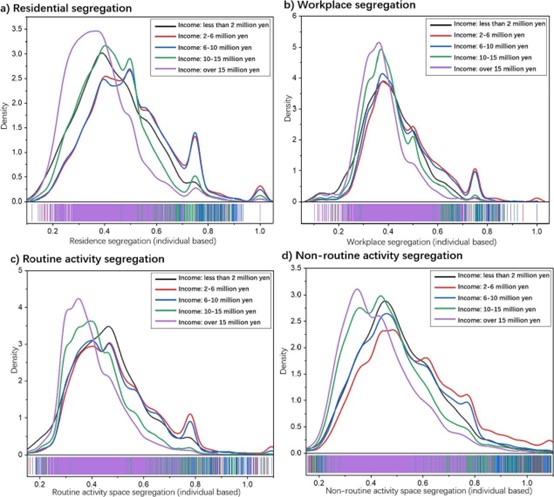
本研究では、首都圏を事例として、活動空間を居住、就労、日常活動、非日常活動の4つに分類し、それらの活動種類に応じて、場所による所得のSegregationと個人の経験所得のSegregationを算出しました。その結果、活動種類に応じてSegregationレベルが異なることがわかりました。居住空間(0.56)および非日常的活動空間(0.60)における平均的な場所に応じた所得のSegregationレベルは、それぞれ就労空間(0.51)および日常的活動空間(0.55)よりも高い傾向にありました。また、郊外は都心部よりも深刻な社会的Segregationを示している事がわかりました。また、20%以上の郊外グリッドでは非日常的な活動スペースのSegregationが高いものの、中心部のグリッドで分離が高いのはわずか5%でした。さらに、世帯年収が高いほど、世帯年収200万円未満の最貧困層を除く全世帯において、個人の経験所得のSegregation水準が低いです。この研究は、都市空間における様々な活動種類のSegregationレベルを、単に1つの特定の視点に焦点を当てるのではなく、比較することの重要性を示しています。
This research takes the Tokyo metropolitan area as a case. We classify the activity spaces into four categories: residential, working, routine activities, and non-routine activities, and then calculate the place income segregation and individual experienced income segregation under different activity contexts. We found that the segregation levels vary depending on the activity contexts. The average place income segregation level in residential (0.56) and non-routine activity spaces (0.60) tends to be higher than that in the working (0.51) and routine activity spaces (0.55), respectively. Suburban areas exhibit more severe social segregation than central urban areas. Over 20% of suburb grids experience high non-routine activity space segregation, while only 5 % of central grids have high segregation. Furthermore, the higher the household income, the lower the individual experienced income segregation level among all households except the poorest with yearly household income of less than 2 million yen. This work demonstrates the importance of comparing the differences in various activity segregation contexts in urban spaces instead of merely focusing on one specific perspective.
【論文情報】
Sun, C., Shibuya, Y., & Sekimoto, Y. (2024). Social segregation levels vary depending on activity space types: Comparison of segregation in residential, workplace, routine and non-routine activities in Tokyo metropolitan area. Cities, Elsevier, 146 (March 2024) 104745.
https://doi.org/10.1016/j.cities.2023.104745

Figure: Distribution curves of individual experienced income segregation indicators for different income groups.